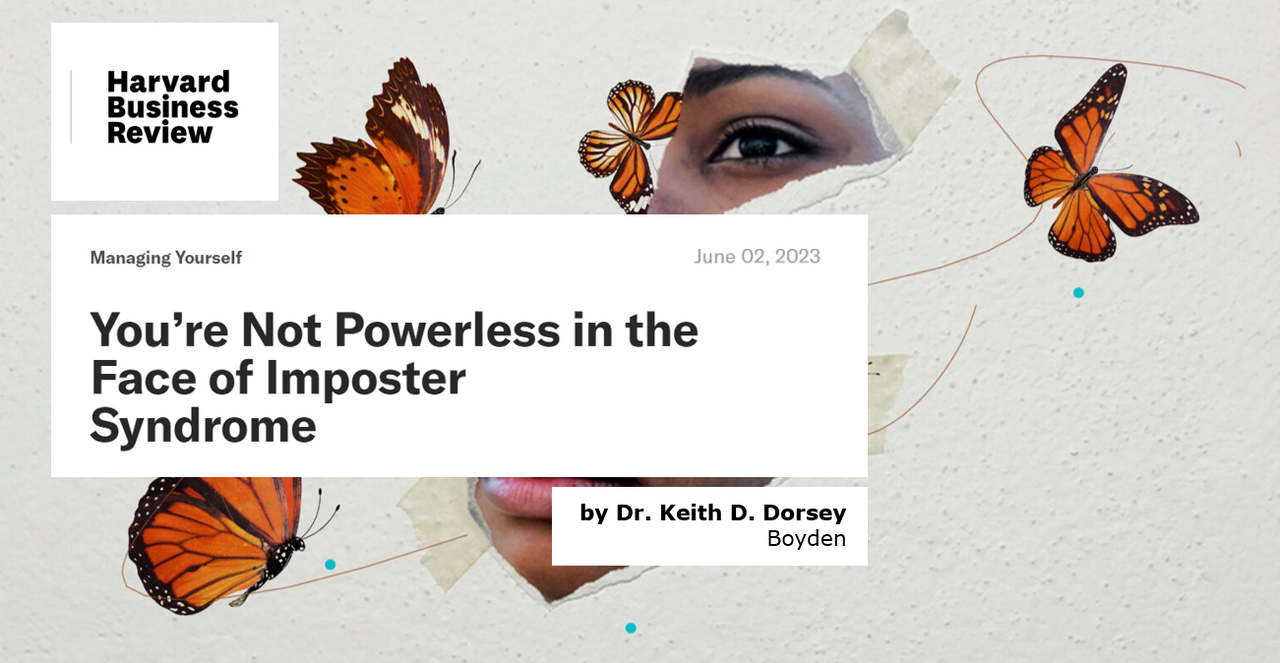Summary: Research shows that high achievers from underrepresented backgrounds often find themselves confronting imposter syndrome or feeling they don’t fit in, are not welcome, or don’t belong. But understanding imposter syndrome does little to end it. The author, who studied underrepresented board members for his PhD and who interacts with hundreds of aspiring and existing board directors in his role at an executive search firm, has found that attributes of moxie — strength of will, self-discipline, and the ability to persist despite challenges — were vital to underrepresented directors’ success. He recommends four tactics to help make moxie your own super power.

“I was intimidated for many years in the early part of my board career because I didn’t have a business degree and felt underprepared,” a female board director once told me. Another director, explaining that she “grew up in the shadows of a plantation” reflected, “It’s still very much a white male show, so the fact that I was the first African American female on the board was astounding to me.”
As U.S. practice leader of CEO and board services at Boyden, an executive search firm, I interact with hundreds of aspiring and existing directors. Questions about their qualifications for board service remain a concern for many of the people I talk to, particularly those from underrepresented backgrounds.
My experience aligns with research that shows that high achievers from underrepresented backgrounds often find themselves confronting imposter syndrome, or doubting their skills and achievements or fearing being exposed as a fraud. Women and people of color may be more likely to feel they don’t fit in, they’re not welcome, and they don’t belong.
Imposter syndrome can be crippling mentally and emotionally, drain your energy and attention, and cause you to fall short of the performance you are capable of, thus, feeding the cycle of self-doubt. If you experience imposter syndrome, you may explain away your successes by thinking anyone could have done what you did, or thinking you just got lucky, or fearing that others are mistaken in believing that you’re talented. As if that isn’t bad enough, when you stumble or face challenges, your self-perceived incompetence looms larger than life — increasing your chance of failure and perpetuating the syndrome.
While awareness of this cycle is helpful, understanding imposter syndrome does little to end it. Instead, you need action. And to take action, you need moxie.
Moxie: A Working Definition
Moxie reflects an intensity of motivation and is related to (but distinct from) traits such as grit, self-control, and the ability to overcome procrastination. The term was popularized by a 1920s soft drink advertised to give its drinkers vigor, nerve, and pep. After Boston Red Sox player Ted Williams endorsed the drink, moxie entered the cultural consciousness as shorthand for strength, aggressiveness, skill, and know-how.
In my own research, I’ve seen that the attributes of moxie — strength of will, self-discipline, and the ability to persist despite challenges — was vital to underrepresented directors’ success. One Latina executive I spoke with described moxie in this way: “I noticed my Black colleagues overcoming the objections coming at them in their careers. Whenever they set goals, they achieved them. They had a ‘refuse to lose’ mentality. And once I emulated what I saw in them, I rapidly ascended the corporate ladder myself.”
The directors I interviewed explained that they neither internalized the obstacles they encountered as personal failures, nor did they externalize them as irreconcilable systemic barriers. In fact, when I asked them to identify the barriers they faced, it took them a while to recall and identify them because they had transformed their obstacles into sources of motivation. It became apparent that moxie was a response to their childhood experiences of racism, sexism, microaggression, and other difficulties.
If you are a woman or person of color and you want to push forward and advance in your career, you will encounter obstacles and you will experience failure. At these times, you have a choice to make: Will you allow the obstacles and failures to feed imposter syndrome, or will you pick yourself up and use moxie to persist toward your goal?
If you choose moxie, you may not be disappointed. In a study by psychology professor Jessica Curtis and colleagues, moxie was found to predict intrinsic and extrinsic motivation more than other motivational constructs like grit or self-control. Moxie also predicted goal achievement — largely because people with moxie invest more resources into their aims. For example, one director I interviewed realized that her career choice of spending years as a consultant and then becoming CEO of a small company created substantial obstacles to her landing a corporate board seat. “Boards still tend to recruit against a checklist of wanting a sitting CEO of a multinational corporation,” she explained. “So when I’d approach recruiters, they would push back with, ‘Ooo…ah…I’ll really have to convince the board that it is worth it for them to speak with you.’” At this point, she could have agreed with others’ opinions that she wasn’t boardroom material. Instead, she recognized the need to translate her experiences and skills into language a board would understand and find attractive. Now, only a few years into board service, she sits on three publicly traded company boards and three nonprofit boards.
Making Moxie Your Superpower
Based on the experiences of the underrepresented directors I interviewed in my study and the aspiring and existing directors I continue to interact with, I suggest four tactics to help you make moxie your very own superpower:
1. Utilize the strengths you’ve forged through culture-based hardships.
People of color have endured centuries of hardship and oppression and, through these, we have forged attitudes and approaches that give us unique advantages, as research regarding racism-related coping and posttraumatic growth following racial trauma has shown. Tabitha Grier-Reed and colleagues at the University of Minnesota have found that deepening your connections with others, harnessing your inner strengths, developing fresh perspectives and appreciation for life, and connecting with your spirituality, in particular, help us grow and flourish in our careers and life.
One Black women board member I interviewed explained that her grandparents had raised her to understand the inequity of opportunities presented to people of color. As a result, she persisted through barriers because, as she put it: “I had no choice. Like other women of my generation, we were told by our parents and grandparents to just get out there and do it. Make it happen. If you’re given an opportunity, demonstrate to them that you deserve the opportunity.” Similarly, the other directors I interviewed explained that they learned to ignore, go under, go over, go around, or go through any obstacles put in front of them — in other words, they used moxie.
To turn your own hardships into moxie, identify a challenging situation from your past that you ultimately overcame. Reflect on how you got through it and how you resolved the situation. Finally, formulate these as the principles you learned and strengths you gained. Together, these are some ingredients of your unique brand of moxie.
For example, women and students of color commonly report facing negative stereotypes when enrolling in STEM courses. One such woman recalled, “I had to take organic chemistry, but without the years of preparatory courses all my classmates had. So I had lots of questions that seemed very elementary to others. As a result, everyone — students, lecturers, and my mentor — thought I didn’t belong there and refused to help me.” To overcome this formidable challenge, she explained, “I spent many sleepless nights reading extra material, going over class notes and homework multiple times, and slowly caught up. I ultimately graduated from my degree program with one of the highest grades.” From this experience, this young woman recognized that she relished challenge and realized she could rely on her strengths of a strong work ethic, self-discipline, focus, and ability to learn unfamiliar, scientific material with limited support. This moxie continued to help her flourish in her career.
2. Give yourself permission to play.
Herminia Ibarra, professor at London Business School, has conducted extensive research on what she calls “identity play,” which involves experimenting with new ideas and behaviors as you take on new professional challenges and roles. She uses the term “play” to normalize the idea that you won’t perform as well in the new role as you do in more familiar roles.
Importantly, play is not a “fake it till you make it” situation. Instead, it’s about authentically growing into new roles by trying new behaviors, gaining confidence, and allowing yourself time and space for development. This was a critical tactic for one director I interviewed, who explained, “Debt financing, bond markets, and the investor base were foreign concepts to me. So when these came up, I reminded myself that I had to have just enough knowledge to stay on the stage, and I kept trying and focused on being a learner.”
To foster your own identity play, think of a work situation where you are still on a learning curve. Break the situation or role into a series of small learning experiences with deliberate action planning, experimentation, and gathering data on your performance. Then repeat the cycle.
3. Tune out the naysayers.
If you are working hard to achieve much in your career and life, you are bound to encounter naysayers who are more than eager to point out the ways you don’t measure up. The late Kaleel Jamison, a pioneering career woman in 1970s corporate America, called these messages “nibbles” intended to make you smaller.
When you agree with the nibble (or, worse, initiate the nibble yourself), you feed the imposter syndrome. I recently witnessed this in a young and talented mentee of mine who has been spearheading transformative change in her company despite having taken her role only months ago. While her proposed initiative had been blessed by her boss and her CEO, another leader above her blocked her with, “Well, your plan is completely unworkable.” She slid into a pit of paralyzing self-doubt. Having seen the plan myself, I knew the criticism was unfounded but suspected there was more to the story. Once we debriefed on the situation, I realized that she had circulated her plan in a way that inadvertently criticized the leader’s work, resulting in a predictable backlash. We then discussed more effective ways to solicit support from the various stakeholders involved—including the leader in question. She then created and implemented a more successful approach, in turn, learning from this experience and strengthening her competencies.
When you experience criticism, begin by reframing it as a hypothesis (e.g., “The plan will not work”). Next, identify ways to test the hypothesis, such as by getting feedback from trusted mentors or conducting a low-risk proof of concept. Third, gather data and test the hypothesis. Regardless of the results, you will gain concrete and actionable feedback that will help you progress.
4. Recognize when to walk away.
Imposter syndrome often is used to mask systemic bias and racism in the workplace, as Ruchika Tulshyan and Jodi-Ann Burey aptly noted. This means that moxie won’t work in every situation.
One director I interviewed had a longstanding dream to become the CEO at her employer. “I eventually realized that even though I was performing well, I couldn’t control how the leadership decided who actually got C-suite opportunities and who didn’t. So, I made the hard decision that I still wanted to be a CEO, but it didn’t have to be there. And I left.”
When you encounter an obstacle, take time to assess the competencies, energy, and passion you would need to overcome it, and then soberly evaluate whether you want to invest your resources in this way. For example, if you discover that success requires knowledge or skills you don’t have and cannot realistically develop in the needed time frame, or when you cannot get the mentoring or advocacy you need to succeed, it may be wiser to walk away. When you deliberately evaluate the obstacles facing you, you will either take on the challenges fully informed, or reallocate your abilities in more suitable environments.
I will be the first to admit that the steps I describe above are not easy. Turning away from the imposter syndrome and embracing your moxie requires you to re-examine your assumptions, values, and beliefs; risk new behaviors; and commit more to yourself and your growth than you may ever have before. In other words, embracing moxie sets you on a path of transformative learning, which is rooted in the truism that growth comes from discomfort. As the old man in George Bernard Shaw’s Back to Methusaleh noted, “Life is not meant to be easy, my child, but take courage, for it can be delightful.”
This article was originally published by Harvard Business Review. Click here to view the original article.




